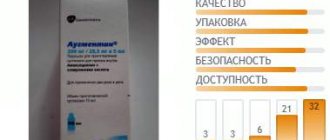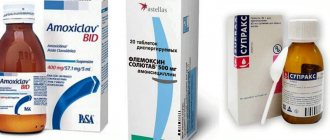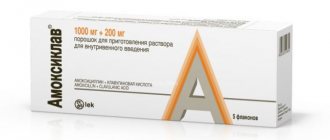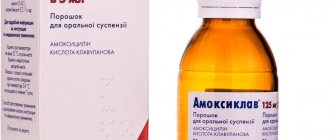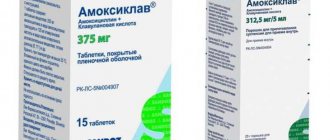Indications for use
Treatment of infections caused by sensitive microorganisms in children:
- ENT infections: recurrent or persistent acute otitis media caused by Streptococcus pneumoniae (MIC ≤ 4 μg/ml), Haemophilus influenzae and Moraxella catarrhalis *;
- tonsillopharyngitis and sinusitis, usually caused by Streptococcus pneumoniae, Haemophilus influenzae*, Moraxella catarrhalis and Streptococcus pyogenes;
- lower respiratory tract infections: lobar pneumonia and bronchopneumonia caused by Streptococcus pneumoniae, Haemophilus influenzae*, Moraxella catarrhalis*;
- infections of the skin and soft tissues, usually caused by Staphylococcus aureus and Streptococcus pyogenes.
Infections caused by microorganisms sensitive to amoxicillin can be treated with Augmentin® EC, since amoxicillin is one of its active ingredients. The drug Augmentin® EC is also indicated for the treatment of mixed infections caused by microorganisms sensitive to amoxicillin, as well as microorganisms producing β-lactamase, sensitive to the combination of amoxicillin with clavulanic acid. The sensitivity of bacteria to the combination of amoxicillin and clavulanic acid varies regionally and over time. Where possible, local sensitivity data should be taken into account. If necessary, microbiological samples should be collected and bacteriological susceptibility testing should be carried out.
Augmentin EU nosological classification
Gonococcal infection. Purulent and unspecified otitis media. Acute sinusitis. Streptococcal tonsillitis. Acute tonsillitis, unspecified (angina agranulocytic). Acute upper respiratory tract infections of multiple and unspecified localization. Pneumonia caused by Streptococcus pneumoniae. Pneumonia caused by Haemophilus influenzae [Afanasyev-Pfeiffer bacillus]. Bronchopneumonia, unspecified. Lobar pneumonia, unspecified. Acute bronchitis caused by Haemophilus influenzae [Afanasyev-Pfeiffer bacillus]. Acute bronchitis caused by streptococcus. Acute bronchitis caused by other specified pathogens. Chronic sinusitis, unspecified. Chronic tonsillitis. Upper respiratory tract disease, unspecified. Chronic bronchitis, unspecified. Peritonitis. Local infection of the skin and subcutaneous tissue, unspecified. Staphylococcal arthritis and polyarthritis. Pyogenic arthritis, unspecified (infectious). Osteomyelitis. Other osteomyelitis. Unspecified bone disease. Tubulointerstitial nephritis, not specified as acute or chronic. Cystitis, unspecified. Urethritis and urethral syndrome. Urinary tract infection without established localization. Inflammatory diseases of the female pelvic organs, unspecified. Gonococcal inflammatory diseases of the female pelvic organs (A54.2+). Infection of the genital tract and pelvic organs caused by abortion, ectopic and molar pregnancy. Postpartum sepsis
Directions for use and doses
Dosing of the drug Augmentin® EC is carried out in accordance with the age of the child, the dose is calculated in mg per kg per day or in ml of the finished suspension. Dosage calculations are based on amoxicillin and clavulanic acid, except in cases where dosing is carried out for each component separately. To minimize potential adverse events from the gastrointestinal tract and optimize absorption, the drug should be taken orally at the beginning of a meal.
Treatment should not be continued for more than 14 days without reviewing the clinical situation.
If necessary, it is possible to carry out stepwise therapy (initially, intravenous administration of the drug Augmentin® (powder for preparing a solution for intravenous administration) followed by switching to oral administration).
Augmentin® EC is recommended for children aged 3 months and older. There is no experience with the use of Augmentin® EC in children under 3 months.
The recommended daily dose is 90 mg of amoxicillin and 6.4 mg of clavulanic acid per 1 kg of body weight, divided into 2 doses every 12 hours, for 10 days.
For patients weighing more than 40 kg, other dosage forms of Augmentin® are recommended.
In terms of the content of clavulanic acid, Augmentin® EC differs from other suspensions containing amoxicillin and clavulanic acid. The drug Augmentin® EC contains 600 mg of amoxicillin and 42.9 mg of clavulanic acid in 5 ml of reconstituted suspension, while preparations containing 200 mg and 400 mg of amoxicillin in 5 ml of suspension contain, respectively, 28.5 mg and 57 mg of clavulanic acid in 5 ml of suspension . Preparations in the form of suspensions with a dosage of 200 mg of amoxicillin in 5 ml, 400 mg of amoxicillin in 5 ml and the drug Augmentin®EC are not interchangeable.
In patients with impaired liver function, treatment is carried out with caution; regularly monitor liver function. There is insufficient data to change the recommended dosage regimen in these patients.
Method of preparing the suspension. The suspension is prepared immediately before the first use.
Approximately 2/3 of the volume of boiled water, cooled to room temperature, should be added to the powder, then close the bottle with a lid and shake until the powder is completely diluted, let the bottle stand for 5 minutes to ensure complete dilution. Then add water up to the mark on the bottle and shake the bottle again. The bottle should be shaken well before each use. For accurate dosing of the drug, you should use a measuring spoon, which must be rinsed well with water after each use. After dilution, the suspension should be stored for no more than 10 days in the refrigerator, but not frozen.
Similar drugs:
- Augmentin Oral tablets
- Tea tree DN Ointment for external use
- Augmentin Powder for suspension for oral administration
- Bactrim Oral suspension
- Dioxydin Mouth rinse solution
- Pancef Oral tablets
- Nifuroxazide (Nifuroxazide) Oral tablets
- Cifran OD Oral tablets
- Pancef Granules for the preparation of suspension for oral administration
- Benzylpenicillin Powder for injection solution
** The Drug Directory is intended for informational purposes only. For more complete information, please refer to the manufacturer's instructions. Do not self-medicate; Before you start using Augmentin EC, you should consult a doctor. EUROLAB is not responsible for the consequences caused by the use of information posted on the portal. Any information on the site does not replace medical advice and cannot serve as a guarantee of the positive effect of the drug.
Are you interested in the drug Augmentin EU? Do you want to know more detailed information or do you need a doctor's examination? Or do you need an inspection? You can make an appointment with a doctor - the Euro lab is always at your service! The best doctors will examine you, advise you, provide the necessary assistance and make a diagnosis. You can also call a doctor at home . Euro lab clinic is open for you around the clock.
** Attention! The information presented in this medication guide is intended for medical professionals and should not be used as a basis for self-medication. The description of the drug Augmentin EU is provided for informational purposes and is not intended for prescribing treatment without the participation of a doctor. Patients need to consult a specialist!
If you are interested in any other drugs and medications, their descriptions and instructions for use, information about the composition and form of release, indications for use and side effects, methods of use, prices and reviews of drugs, or you have any other questions and suggestions - write to us, we will definitely try to help you.
Contraindications
- history of hypersensitivity to amoxicillin, clavulanic acid, other components of the drug, beta-lactam antibiotics (for example, penicillins, cephalosporins);
- history of previous episodes of jaundice or impaired liver function when using a combination of amoxicillin and clavulanic acid;
- children up to 3 months;
- impaired renal function (creatinine clearance <30 ml/min);
- phenylketonuria.
With caution: liver dysfunction.
Augmentin EU composition
Powder for the preparation of suspension for oral administration 5 ml
Active ingredients: Amoxicillin trihydrate1 (in terms of amoxicillin) - 697.65 (600) Potassium clavulanate2 (in terms of clavulanic acid) - 52.31 (42.9)
Excipients: Xanthan gum - 3.26 Aspartame - 13.6 Silicon dioxide - 153.29 Colloidal silicon dioxide - 38.08 Sodium carmellose - 32.64 Strawberry flavor - 28.29
1 in the production of amoxicillin trihydrate is added with an 8.8% excess.
2 in the production of the drug, potassium clavulanate is added with an 8% excess at the initial stage of mixing the active components and with 8.8% at the stage of mixing all components of the suspension.
special instructions
Before starting treatment with Augmentin® EC, it is necessary to obtain a detailed history regarding previous hypersensitivity reactions to penicillins, cephalosporins or other allergens.
Serious and sometimes fatal hypersensitivity reactions (including anaphylactic reactions) to penicillins have been described. The risk of such reactions is highest in patients with a history of hypersensitivity reactions to penicillins. If an allergic reaction occurs, you must stop treatment with Augmentin® EC. For severe hypersensitivity reactions, epinephrine should be administered immediately. Oxygen therapy, intravenous administration of corticosteroids, and airway management, including intubation, may also be required. It is not recommended to prescribe Augmentin® EC for suspected infectious mononucleosis, since amoxicillin can cause a measles-like rash in patients with this disease, which makes diagnosing the disease difficult.
Long-term treatment with Augmentin® EC sometimes leads to excessive proliferation of insensitive microorganisms. In general, Augmentin® EC is well tolerated and has the low toxicity characteristic of all penicillins. During long-term therapy with Augmentin® EC, it is recommended to periodically evaluate renal, liver and hematopoietic function. In order to reduce the risk of developing side effects from the gastrointestinal tract, the drug should be taken at the beginning of a meal.
In patients receiving a combination of amoxicillin and clavulanic acid together with indirect (oral) anticoagulants, an increase in prothrombin time (increase in MHO) has been reported in rare cases. When co-prescribing indirect (oral) anticoagulants with a combination of amoxicillin and clavulanic acid, monitoring of relevant indicators is necessary. Dosage adjustments may be required to maintain the desired effect of oral anticoagulants.
In patients with reduced diuresis, the development of crystalluria has been reported in very rare cases, mainly with parenteral use of the drug. During the administration of high doses of amoxicillin, it is recommended to take sufficient amounts of fluid and maintain adequate diuresis to reduce the likelihood of the formation of amoxicillin crystals. Taking Augmentin® EC orally leads to high levels of amoxicillin in the urine, which may lead to false-positive results when determining glucose in the urine (for example, Benedict's test, Fehling's test). In this case, it is recommended to use the glucose oxidant method for determining the concentration of glucose in urine.
Oral care helps prevent tooth discoloration by simply brushing your teeth.
There was no drug dependence, addiction, or euphoric reactions associated with the use of Augmentin® EC.
Since the drug may cause dizziness, patients should be warned to take precautions when driving or operating moving machinery.
Augmentin EU pharmacodynamics
Mechanism of action
Amoxicillin is a semisynthetic broad-spectrum antibiotic that is active against many gram-positive and gram-negative microorganisms. At the same time, amoxicillin is susceptible to destruction by beta-lactamases, and therefore the spectrum of activity of amoxicillin does not extend to microorganisms that produce this enzyme.
Clavulanic acid is a beta-lactamase inhibitor, structurally related to penicillins, and has the ability to inactivate a wide range of beta-lactamases found in microorganisms resistant to penicillins and cephalosporins. Clavulanic acid is quite effective against plasmid beta-lactamases, which most often cause bacterial resistance, and is less effective against type 1 chromosomal beta-lactamases, which are not inhibited by clavulanic acid. The presence of clavulanic acid in Augmentin EC protects amoxicillin from destruction by enzymes - beta-lactamases, which allows expanding the antibacterial spectrum of amoxicillin.
Below is the activity of the combination of amoxicillin and clavulanic acid in vitro.
Bacteria usually susceptible to the combination of amoxicillin and clavulanic acid
Gram-positive aerobes - Bacillus anthracis; Enterococcus faecalis; Listeria monocytogenes; Nocardia asteroides; Streptococcus pneumoniae1,2; Streptococcus pyogenes1,2; Streptococcus agalactiae1,2; Streptococci of the Viridans group Streptococcus spp. (other beta-hemolytic streptococci)1, 2; Staphylococcus aureus (methicillin sensitive)1; Staphylococcus saprophyticus (sensitive to methicillin); coagulase-negative staphylococci (sensitive to methicillin).
Gram-negative aerobes - Bordetella pertussis; Haemophilus influenzae1; Helicobacter pylori; Moraxella catarrhalis1; Neisseria gonorrhoeae; Pasteurella multocida; Vibrio cholerae.
Others - Borrelia burgdorferi; Leptospira icterohaemorrhagiae; Treponema pallidum.
Gram-positive anaerobes - Clostridium spp.; Peptococcus niger; Peptostreptococcus magnus; Peptostreptococcus micros; Peptostreptococcus spp.
Gram-negative anaerobes - Bacteroides fragilis; Bacteroides spp.; Capnocytophaga spp.; Eikenella corrodens; Fusobacterium nucleatum; Fusobacterium spp.; Porphyromonas spp.; Prevotella spp.
Bacteria for which acquired resistance to the combination of amoxicillin and clavulanic acid is likely
Gram-negative aerobes - Escherichia coli1; Klebsiella oxytoca; Klebsiella pneumoniae1; Klebsiella spp.; Proteus mirabilis; Proteus vulgaris; Proteus spp.; Salmonella spp.; Shigella spp.
Gram-positive aerobes - Corynebacterium spp.; Enterococcus faecium.
Bacteria that are naturally resistant to the combination of amoxicillin and clavulanic acid
Gram-negative aerobes - Acinetobacter spp. Citrobacter freundii; Enterobacter spp.; Hafnia alvei; Legionella pneumophila; Morganella morganii; Providencia spp.; Pseudomonas spp.; Serratia spp.; Stenotrophomonas maltophilia; Yersinia enterocolitica.
Others - Chlamydia pneumoniae; Chlamydia psittaci; Chlamydia spp.; Coxiella burnetii; Mycoplasma spp.
1 for these bacteria, the clinical effectiveness of the combination of amoxicillin with clavulanic acid has been demonstrated in clinical studies;
2 strains of these types of bacteria do not produce beta-lactamases. Sensitivity during amoxicillin monotherapy suggests similar sensitivity to the combination of amoxicillin and clavulanic acid.
Augmentin EU overdose
Gastrointestinal disorders and disturbances in water and electrolyte balance may occur.
Symptoms: gastrointestinal symptoms and water and electrolyte imbalance may be observed. Amoxicillin crystalluria has been described, in some cases leading to the development of renal failure (see "Special Instructions").
Convulsions may occur in patients with impaired renal function, as well as in those receiving high doses of the drug.
Treatment: symptoms from the gastrointestinal tract - symptomatic therapy, paying special attention to the normalization of water and electrolyte balance. Amoxicillin and clavulanic acid can be removed from the bloodstream by hemodialysis. The results of a prospective study that was conducted in 51 children at a poison control center showed that amoxicillin administered at a dose of less than 250 mg/kg did not lead to significant clinical symptoms and did not require gastric lavage.
Augmentin EU interaction
The simultaneous use of Augmentin EC and probenecid is not recommended. Probenecid reduces the tubular secretion of amoxicillin, and therefore the simultaneous use of Augmentin EC and probenecid may lead to an increase and persistence in the blood concentration of amoxicillin, but not clavulanic acid.
Concomitant use of allopurinol and amoxicillin may increase the risk of allergic skin reactions. Currently, there is no data in the literature on the simultaneous use of a combination of amoxicillin with clavulanic acid and allopurinol.
Penicillins can slow down the elimination of methotrexate from the body by inhibiting its tubular secretion, so the simultaneous use of Augmentin EC and methotrexate may increase the toxicity of methotrexate.
Like other antibacterial drugs, Augmentin EC can affect the intestinal microflora, leading to a decrease in the absorption of estrogens from the gastrointestinal tract and a decrease in the effectiveness of combined oral contraceptives.
The literature describes rare cases of increased INR in patients with the combined use of acenocoumarol or warfarin and amoxicillin. If it is necessary to simultaneously prescribe Augmentin EC with anticoagulants, PT or INR should be carefully monitored when prescribing or discontinuing Augmentin EC; dose adjustment of anticoagulants for oral administration may be required.
Analogs
Amoxiclav
Sandoz, Switzerland Price:
230 rubles
Prescribed for the treatment of inflammatory and infectious diseases. Available in the form of tablets and suspension.
Advantages:
- Effective in treating a wide range of diseases
- Sold at a reasonable price
- Patients note a rapid recovery process.
Flaws:
- Some patients report problems with urination
- A slight increase in temperature appears, which interferes with a full life.
Augmentin EU pharmacokinetics
The active ingredients of Augmentin EC - amoxicillin and clavulanic acid - are quickly and completely absorbed from the gastrointestinal tract after oral administration. Absorption of active ingredients is optimal when taking Augmentin EC with food.
The following are the pharmacokinetic parameters of amoxicillin and clavulanic acid after administration at a dose of 45 mg/kg every 12 hours in patients under 12 years of age.
Average values of pharmacokinetic parameters
Distribution. As with intravenous administration of a combination of amoxicillin and clavulanic acid, therapeutic concentrations of amoxicillin and clavulanic acid are found in various tissues and interstitial fluid (gallbladder, abdominal tissue, skin, adipose and muscle tissue, synovial and peritoneal fluids, bile, purulent separable).
Amoxicillin and clavulanic acid have a weak degree of binding to plasma proteins. Studies have shown that about 25% of the total amount of clavulanic acid and 18% of amoxicillin in the blood plasma is bound to plasma proteins. In animal studies, no accumulation of the components of Augmentin® EC in any organ was detected.
Amoxicillin, like most penicillins, passes into breast milk. Trace amounts of clavulanic acid may also be found in breast milk. With the exception of the possibility of diarrhea and candidiasis of the oral mucosa, no other negative effects of amoxicillin and clavulanic acid on the health of breastfed infants are known. Animal reproductive studies have shown that amoxicillin and clavulanic acid cross the placental barrier. However, no negative effects on the fetus were detected.
Metabolism. 10–25% of the initial dose of amoxicillin is excreted by the kidneys in the form of an inactive metabolite (penicillic acid). Clavulanic acid is extensively metabolized to 2,5-dihydro-4-(2-hydroxyethyl)-5-oxo-1H-pyrrole-3-carboxylic acid and 1-amino-4-hydroxy-butan-2-one and is excreted by the kidneys. through the gastrointestinal tract, as well as with exhaled air in the form of carbon dioxide.
Excretion. Like other penicillins, amoxicillin is eliminated primarily by the kidneys, while clavulanic acid is eliminated through both renal and extrarenal mechanisms. Approximately 60–70% of amoxicillin and about 40–65% of clavulanic acid are excreted unchanged by the kidneys in the first 6 hours after administration of 1 tablet. 250/125 mg or 1 tablet. 500/125 mg. Concomitant administration of probenecid slows the elimination of amoxicillin, but not clavulanic acid (see “Interactions”).
Positive reviews
If your doctor has prescribed Augmentin EC, reviews will help you navigate and make a final decision about taking this drug. So, among the positive comments it is worth noting the following:
- the drug combines two active substances that are characterized by pronounced antibacterial activity;
- the suspension is prepared quickly and easily (just add cool boiled water);
- quickly copes with complex diseases;
- the package contains detailed detailed instructions from which you can obtain comprehensive information about the drug;
- The kit includes a spoon that can easily be used to measure the required amount of suspension;
- the medicine smells pleasant of fruits and berries;
- improvement in the condition is often observed after the first day of taking the drug (provided that it was chosen correctly).

